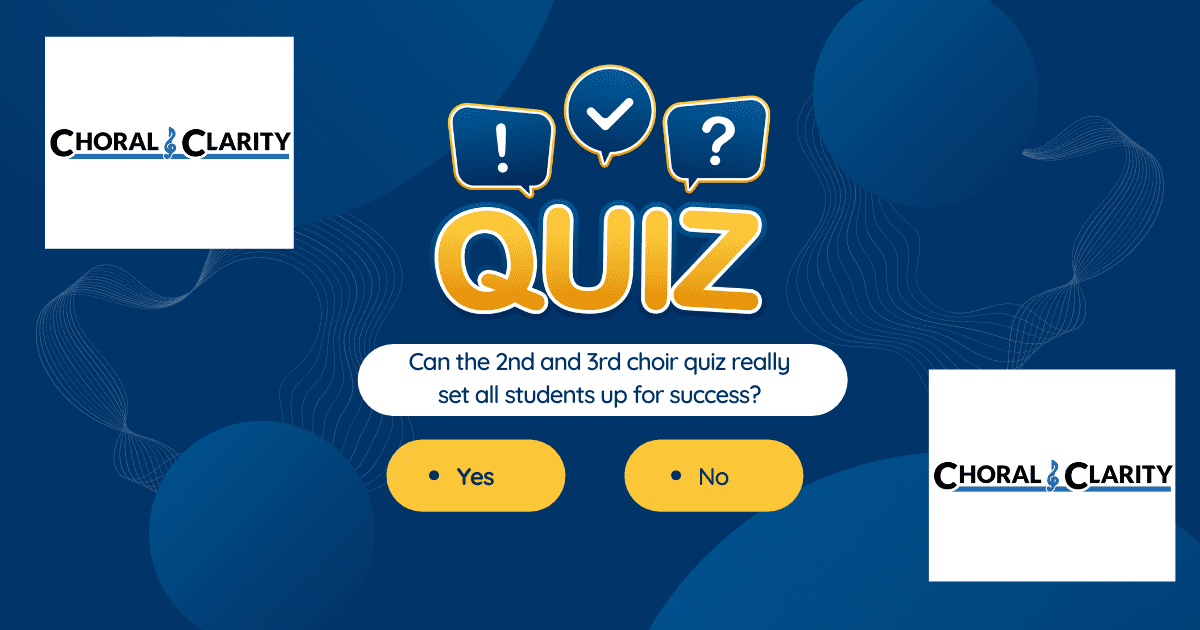For more than a decade, my rehearsal approach for the month of January can be described as a choral break! This year will be slightly different due to the pandemic, but the concepts will remain the same.
I have found that taking a break from choral repertoire instills in our choral members that there is more to the class than just preparing for concerts (in this case, virtual concerts). One completed performance doesn’t mean we have to “start over” instantly, and prepare for the one.
Prior to implementing the “JANUARY CHORAL BREAK” approach, I found students would act sluggish, unfocused, and disinterested in the process of learning new music; students just came off a performance high and winter break. Prior to that, rehearsals consisted of well-prepared, memorized music. All of a sudden, that comfortable, already learned music is gone, and they have a big uphill music mountain to climb; they also couldn’t see the end in sight as their next concert wasn’t for several months.
In these unprecedented times, our next “virtual” or “live-streamed social distanced” performance is always one step away from falling apart due to unforeseen circumstances. If given the choice, I would recommend a different curricular approach that is far less stressful, musically enriching, and may also improve the vibe in the rehearsal.
I believe there is so much more to be learned in a choir rehearsal than choir music. With the approach I explain below, my students become invigorated on February 1st, when they start their new choral music. Not only are they excited, they read better, sing more in tune and with more confidence. The speed that we learn music for the second-half of the school year is infinitely faster than the first half.
Whether your singers are in-person, hybrid, or fully remote, this approach can be successful. This “January Choral Break” may be a mental and emotional change for both you and your students, and may end up making the February-May rehearsals more productive, focused, and rewarding.
Try SIGHT READING FACTORY and save 10% using code: choralclarity
Here is my “January Choral Break” Approach:
1. Refocus on Basic Ear-Training Patterns
Every singer will benefit from repeated patterns daily as part of the daily warm-up. Singers should sing a scale, followed by patterns such as ascending and descending 3rds (unison followed by harmony), 4th patterns (do, fa, re, sol), 5th patterns, and triads. The repetition of singing the same interval patterns will vastly improve vocal technique, intonation, and the development of their ear.
Brand New: SSAA setting of Robert Frost’s “Stopping by the Woods on a Snowy Evening”
2. Be Spontaneous with Ear-Training Intervals
Ear-training can be a really fun, engaging, and productive activity. I believe in making it interactive while also eliminating note-reading from the equation. By calling out specific intervals, an entire class can be engaged all at once. Remote students can respond on mute while recording their performance on Flipgrid.
After students finish their warm-up, sing a scale and the basic interval patterns described above, I call out patterns such as, “sing a triad on ‘do’ “, “sing a triad on ‘do’.” I may then pick random pitches for them to sing, such as: ” ‘do’ ‘fa’ ‘re’ ” or “‘mi’ ‘la’ ‘re’ “. When they are incorrect, I have them return to ‘do’ and try again. If all students all remote, I would recommend replaying ‘do’ before each exercise since we won’t know in real time if they have lost their ‘do’.
3. Transition into the Aural training sheet
As explained in The Best Ear-Training Exercise You Will Ever Use, this simple sheet can be used every day for the entire year; these exercises are a great transition from interactive aural training to note-reading. Students have to follow the written solfege syllables and track them with their fingers while singing. After the group completes a few lines, the exercise can be enhanced by having each section (soprano, alto, etc) sing 3-4 consecutive syllables with each additional section continuing and singing the next 3-4 syllables, etc., all done to a slow beat. It can become a fun elimination or sectional battle game and an amazing ear training tool. If fully remote, I may have several students volunteer individually sing a line, or have 3 students at a time unmute their microphone and do the same exercise as described. You would be surprised how many students can be engaged independently with an exercise like this, even remotely. At the same time, all muted students could simultaneously record themselves on Flipgrid.
4. Perform Daily Sight-Singing using Sight Reading Factory
Before I purchased a subscription to Sight Reading Factory 6 years ago, I would put up one 8 measure exercise per day on the board. Since implementing Sight Reading Factory, I give each choir 3-4 exercises daily, pinpointing a specific area of focus for each rehearsal. The program allows me to set/save specific parameters for unlimited computer-generated exercises regarding specific time signatures, key signatures, note types, rhythms, intervals, etc. As a result, I can move from one exercise to the next with one click. One day, I may give my students 3-4 6/8 time exercises. The next day I might create an exercise in one specific key signature and time signature, and drill a syncopated rhythm or tricky interval. The program is really intuitive and virtually every feature can be sampled for free by clicking the TRY IT FOR FREE button on their home page; you don’t even have to sign up or give your email in order to try it out instantly! (if you do choose to purchase an annual subscription, use code: choralclarity for 10% off! all subscriptions)
This program is brilliant for remote students. First off, it is easy to share your screen with your students and do sight-singing. Again, Flipgrid is a simple tool to have them record and submit. If you theoretically asked them to record their attempt and gave them 2-3 tries at an exercise, it would be quite easy for you to listen back. In this scenario, you would be hearing the same exercise over and over again by your students so it would take very little time to assess if students are understanding and improving their skills.
This year, for the first time, I’ve provided all students with student subscriptions; now, in addition to weekly homework assignments, on fully remote days, I frequently give individualized sight-singing assignments for students to complete.
Try SIGHT READING FACTORY and save 10% using code: choralclarity
5. Work on Solo Repertoire
Teaching solo repertoire is wonderful for so many reasons. Unison singing allows all students to be engaged for the entire time while singing throughout their range; solo melodies are not limited to a choir part, and therefore singers sing outside their section’s common choral tessitura. As a result of singing with more range, they will develop more flexibility. On top of this, they learn music that they can sing on their own for outside solo performances, college auditions, and scholarships. More students are likely to sing out in class, since they are singing a melody. This builds their confidence as singers, and in turn, helps to get more sound out of them when they transition back to choral music.
By the end of January, my students are really excited to begin new choral music. They’ve had their break, improved their technique, ear, reading, confidence, and gained solo repertoire in the process!
Original setting of Robert Frost’s “The Road Not Taken”







Leave A Comment